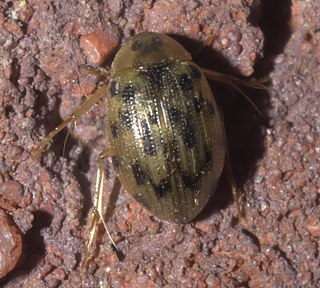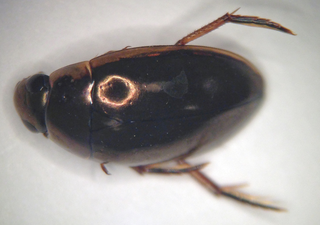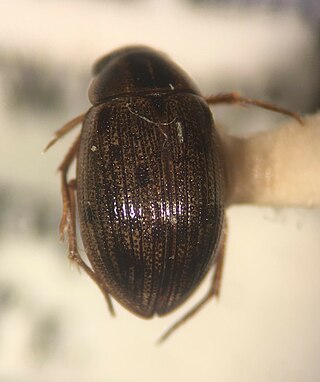
John Lawrence LeConte MD was an American entomologist, responsible for naming and describing approximately half of the insect taxa known in the United States during his lifetime, including some 5,000 species of beetles. He was recognized as the foremost authority on North American beetles during his career, and has been described as "the father of American beetle study".

Hydrophilidae, also known colloquially as water scavenger beetles, is a family of beetles. Aquatic hydrophilids are notable for their long maxillary palps, which are longer than their antennae. Several of the former subfamilies of Hydrophilidae have recently been removed and elevated to family rank; Epimetopidae, Georissidae, Helophoridae, Hydrochidae, and Spercheidae. While the majority of hydrophilids are aquatic, around a third of described species are terrestrial, mostly belonging to the subfamily Sphaeridiinae.

Hydrochus is the only living genus of beetle in the family Hydrochidae, which belongs to the superfamily Hydrophiloidea, and was formerly treated as a subfamily of Hydrophilidae. Hydrochus includes about 180 species, which are found worldwide. The name "Hydrochus" has also been used for a fly genus in the family Dolichopodidae, but this is a junior subjective synonym of the genus Rhaphium.

Berosus is a genus of beetles in the family Hydrophilidae, the water scavenger beetles. The genus contains 273 species. It is distributed worldwide.
Berosus chevrolati is a species of hydrophilid beetles from Cuba.

Berosus exiguus is a species of water scavenger beetles found in the United States, the Bahamas, and Cuba. These beetles are small, ranging from 2.0 to 3.5 mm in length. They can be identified by their small size, yellowish-brown head, distinctly impressed elytral striae (stripes), and often faint spots on the elytra.

Berosus infuscatus is a species of hydrophilid beetle from the United States, Mexico and Cuba.
Berosus interstitialis is a species of hydrophilid beetles from the Bahamas, Haiti, Guadeloupe, the U.S. Virgin Islands, Puerto Rico and Cuba.
Berosus metalliceps is a species of hydrophilid beetles from the United States, Mexico, the Bahamas and Cuba.
Berosus peregrinus is a species of hydrophilid beetles from Canada, the United States and Cuba.
Berosus quadridens is a species of hydrophilid beetles from Mexico, Guatemala, Nicaragua, Costa Rica and Cuba. It was previously considered a synonym of Berosus truncatipennis.
Berosus trilobus is a species of hydrophilid beetles from the Dominican Republic and Cuba.
Berosus undatus is a species of hydrophilid beetles from the United States, Mexico, the Lesser Antilles and Cuba.

Berosus pantherinus is a species of hydrophilid beetle native to the United States. It was originally described by John Lawrence LeConte in 1855 and is characterized by having ten dark spots on each elytron.
Berosus pugnax is a species of hydrophilid beetles native to the United States. It was originally described by John Lawrence LeConte in 1863 and is characterized by having emarginate apices on its elytra.
Berosus ordinatus is a species of hydrophilid beetles native to the United States, specifically in the states of Maryland, Delaware, New York, New Jersey, Pennsylvania, Connecticut, and Rhode Island. It was originally described by John Lawrence LeConte in 1855 and is characterized by slightly divergent and prolonged elytral apices.
Berosus corrini is a species of hydrophilid beetles native to the United States. It was originally described by David P. Wooldridge in 1964 and is characterized by the lack of striae on its elytra, larger size, two projections on its sternal emargination, and laterally-projecting dorsal edges on the parameres.

Tropisternus lateralis is a species of hydrophilid beetle that ranges across much of the Americas.

Berosus sayi is a species of hydrophilid beetles native to the United States. It is a synonym of Berosus striatus, which was originally described by Thomas Say in 1825, and females can be characterized by a small tooth on the suture near the apex of each elytron.

Berosus youngi is a species of water scavenger beetle found in the United States.









